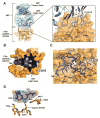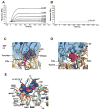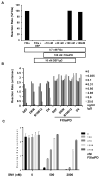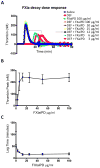Structural Basis for Activity and Specificity of an Anticoagulant Anti-FXIa Monoclonal Antibody and a Reversal Agent
- PMID: 29336885
- PMCID: PMC5803430
- DOI: 10.1016/j.str.2017.12.010
Structural Basis for Activity and Specificity of an Anticoagulant Anti-FXIa Monoclonal Antibody and a Reversal Agent
Abstract
Coagulation factor XIa is a candidate target for anticoagulants that better separate antithrombotic efficacy from bleeding risk. We report a co-crystal structure of the FXIa protease domain with DEF, a human monoclonal antibody that blocks FXIa function and prevents thrombosis in animal models without detectable increased bleeding. The light chain of DEF occludes the FXIa S1 subsite and active site, while the heavy chain provides electrostatic interactions with the surface of FXIa. The structure accounts for the specificity of DEF for FXIa over its zymogen and related proteases, its active-site-dependent binding, and its ability to inhibit substrate cleavage. The inactive FXIa protease domain used to obtain the DEF-FXIa crystal structure reversed anticoagulant activity of DEF in plasma and in vivo and the activity of a small-molecule FXIa active-site inhibitor in vitro. DEF and this reversal agent for FXIa active-site inhibitors may help support clinical development of FXIa-targeting anticoagulants.
Keywords: IgG; active-site inhibitor; anticoagulant; coagulation; crystal structure; factor XI; hemostasis; intrinsic pathway; protease inhibitor; protease-blocking antibody; thrombosis.
Copyright © 2017 Elsevier Ltd. All rights reserved.
Figures








Similar articles
-
Factor XIa-specific IgG and a reversal agent to probe factor XI function in thrombosis and hemostasis.Sci Transl Med. 2016 Aug 24;8(353):353ra112. doi: 10.1126/scitranslmed.aaf4331. Sci Transl Med. 2016. PMID: 27559095
-
Fasxiator, a novel factor XIa inhibitor from snake venom, and its site-specific mutagenesis to improve potency and selectivity.J Thromb Haemost. 2015 Feb;13(2):248-61. doi: 10.1111/jth.12797. Epub 2014 Dec 24. J Thromb Haemost. 2015. PMID: 25418421
-
Crystal structures of the FXIa catalytic domain in complex with ecotin mutants reveal substrate-like interactions.J Biol Chem. 2005 Feb 11;280(6):4704-12. doi: 10.1074/jbc.M411309200. Epub 2004 Nov 15. J Biol Chem. 2005. PMID: 15545266
-
The mechanism underlying activation of factor IX by factor XIa.Thromb Res. 2014 May;133 Suppl 1(0 1):S48-51. doi: 10.1016/j.thromres.2014.03.020. Thromb Res. 2014. PMID: 24759143 Free PMC article. Review.
-
Factor XIa inhibitors: A review of the patent literature.Expert Opin Ther Pat. 2016;26(3):323-45. doi: 10.1517/13543776.2016.1154045. Expert Opin Ther Pat. 2016. PMID: 26881476 Free PMC article. Review.
Cited by
-
Structure of an affinity-matured inhibitory recombinant fab against urokinase plasminogen activator reveals basis of potency and specificity.Biochim Biophys Acta Proteins Proteom. 2021 Feb;1869(2):140562. doi: 10.1016/j.bbapap.2020.140562. Epub 2020 Nov 19. Biochim Biophys Acta Proteins Proteom. 2021. PMID: 33221341 Free PMC article.
-
Sulfonated non-saccharide molecules and human factor XIa: Enzyme inhibition and computational studies.Chem Biol Drug Des. 2022 Jul;100(1):64-79. doi: 10.1111/cbdd.14053. Epub 2022 Apr 11. Chem Biol Drug Des. 2022. PMID: 35377529 Free PMC article.
-
Plasma contact factors as therapeutic targets.Blood Rev. 2018 Nov;32(6):433-448. doi: 10.1016/j.blre.2018.04.001. Epub 2018 Apr 12. Blood Rev. 2018. PMID: 30075986 Free PMC article. Review.
-
Protease Inhibition Mechanism of Camelid-like Synthetic Human Antibodies.Biochemistry. 2020 Oct 13;59(40):3802-3812. doi: 10.1021/acs.biochem.0c00690. Epub 2020 Sep 30. Biochemistry. 2020. PMID: 32997500 Free PMC article.
-
Recent advance in treatment of atherosclerosis: Key targets and plaque-positioned delivery strategies.J Tissue Eng. 2022 Mar 24;13:20417314221088509. doi: 10.1177/20417314221088509. eCollection 2022 Jan-Dec. J Tissue Eng. 2022. PMID: 35356091 Free PMC article. Review.
References
-
- Asakai R, Chung DW, Davie EW, Seligsohn U. Factor XI deficiency in Ashkenazi Jews in Israel. The New England journal of medicine. 1991;325:153–158. - PubMed
-
- Bi L, Lawler AM, Antonarakis SE, High KA, Gearhart JD, Kazazian HH., Jr Targeted disruption of the mouse factor VIII gene produces a model of haemophilia A [letter] Nature genetics. 1995;10:119–121. - PubMed
-
- Bugge TH, Xiao Q, Kombrinck KW, Flick MJ, Holmbäck K, Danton MJ, Colbert MC, Witte DP, Fujikawa K, Davie EW, et al. Fatal embryonic bleeding events in mice lacking tissue factor, the cell-associated initiator of blood coagulation. Proceedings of the National Academy of Sciences of the United States of America. 1996;93:6258–6263. - PMC - PubMed
Publication types
MeSH terms
Substances
Grants and funding
LinkOut - more resources
Full Text Sources
Other Literature Sources

